It’s time for some too-early 2024 rankings, but this time with comments on EVERY ranked player.
Consider this list a very rough draft of the top 200, with my top 300 coming out in February. That list will look different than this one, particularly after the top 50-75 players as free agents sign, trades are executed, and position battles begin in earnest.
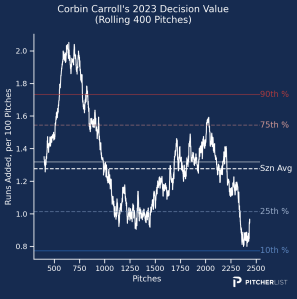
Tier 4
25. Luis Robert Jr. (OF, CWS) – We finally got the full season we’ve been hoping for, and the power and speed did not disappoint as he put up 68 combined home runs and stolen bases. No one should be questioning LuBob’s upside, but there’s plenty of room to question the floor. The strikeout rate rolling chart is one that deeply concerns me as it suggests this new elevated strikeout rate may be here to stay, and it is very difficult to find consistency with a strikeout rate that hovers around 29%—especially when a guy already deals with volatility and health issues. By talent, Robert Jr. should be in Tier 3, but the number of red and yellow flags means he’s best for team builds that already have some stability at the top.
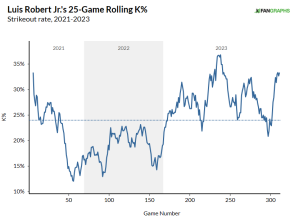
26. Elly De La Cruz (3B/SS, CIN) – De La Cruz is undoubtedly one of the most electrifying athletes in the game, possessing 25+ home run power and 50 stolen base speed, but the 21-year-old infielder has some growing to do in the decision-making department. It might surprise you to know that Elly is actually good at making contact—our PLV contact metrics show that he makes contact more often than we’d expect on a pitch-by-pitch basis when he swings. The primary issue for Elly is that he swings far too often at pitches that no one could do anything with. The exciting part is that we saw Elly start to make this adjustment during the season, and even though the stats didn’t follow (he faded at the end of the season), the fact that his process was dramatically improving makes me very interested in jumping on board with Elly if the price is even remotely reasonable.
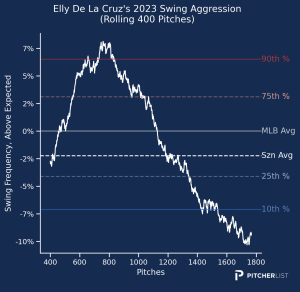
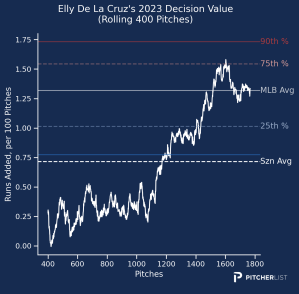
27. Adolis García (OF, TEX) – The power is very real and I expect his 27 home runs from 2022 to be a true floor for 2024, though the lack of steals from García in 2023 is a bit of a bummer considering the improved stolen bases across the league. This downturn is likely a combination of factors—he’s slowing down physically (he’s dropped from 93rd percentile speed when he debuted in 2018 to 49th percentile speed in 2023 according to Statcast), he had a new manager that isn’t known for being overly aggressive (steals were down for multiple Rangers in 2023), and also he now has a significantly improved lineup ahead of him with the additions of Seager and Semien. I’m not expecting most of those missing steals to return as each of these factors is likely to continue in 2024, but García’s raw power and strong supporting cast (that should get even better as Carter and Jung develop) should make the floor high enough to keep him among the top 30 hitters with a ceiling that’s inside the top 20.
28. Michael Harris II (OF, ATL) – Harris II rebounded nicely after the famously slow start to the season. It was so bad that I nearly dropped him off my top 150, though I’m glad I thought better of it as he put up yet another batting average over .290 with almost 20 home runs and exactly 20 stolen bases. It was good to see Harris finally get out of the nine-hole and start hitting closer to the middle of the lineup, which should have an immensely positive impact on his so-far lackluster counting stat totals, and the sub-20% strikeout rate is a credit to his excellent hand-eye coordination and contact ability. Harris is highly unlikely to start taking many walks, but his quick bat and athleticism give him 25-25 upside with a high batting average and improved counting stats.
29. Bo Bichette (SS, TOR) – A second straight season of reduced steals (25 in 2021, 13 in 2022, and just five in 2023) puts the overall upside in question, to be sure, and you have to wonder what he could look like if he started pulling the ball more and/or putting the ball in the air more consistently. The ratios are excellent and should remain excellent, but there has to be more than 25 home runs if the stolen base stoppage continues. This ranking is because I do believe that there’s a path towards more, either with more steals or more home runs, and the floor is so high that I couldn’t justify dropping him further.
Tier 5
30. Jose Altuve (2B, HOU) – I’m not ready to say that injuries are a huge issue for Altuve, though he’s heading into his age-34 season and is coming off the most missed games in his career. On the bright side, Atluve gave us 17 home runs and 14 steals in just 90 games with a .311 batting average, which is a 30-home run, 25-stolen base pace over 162 games and a 26-home run, 21-stolen base pace over a more realistic 140 games. The Astros should continue to be a highly competitive team in 2024, and as long as Altuve is in the lineup, he should contribute to all five categories.
31. Manny Machado (3B, SDP) – A down year for Machado is 30 home runs, 91 RBI, and a .258 batting average, it seems. The highly dependable third baseman has been a strong contributor at third base for nine consecutive seasons, and it’s hard to imagine Machado not doing it again in 2024. There are some questions about how much talent will be around him during the season with Soto being traded and Tatis having a worrisome injury history plus a bit of a downturn in performance. Even if the Padres aren’t a high-powered offense in 2024, Machado has shown he can produce in just about any environment. He’s not getting younger, but he should be a high-floor option who bats in the heart of the order on a team that, at worst, should still be pretty decent at the top half of the order.
32. Gunnar Henderson (3B/SS, BAL) – It was rough for two full months as Henderson hit just .201/.332/.370 with a 31% strikeout rate through the end of May with many questioning whether he’d be a bust for 2023. The script flipped quickly, though, as he slashed .278/.323/.538 over the remainder of the season with 23 home runs, 72 runs scored, 68 RBI, and eight steals with a dramatically reduced 23.3% strikeout rate. Making that adjustment was critical in understanding Henderson’s floor for this season, and it was very good news.
I’m curious about whether they’ll keep Henderson at the top of the order or if they’ll ever let Mullins sneak back into that role, but regardless Henderson should have a prime spot in a lineup that surprised in 2023 and should get even stronger in 2024.
33. Randy Arozarena (OF, TBR) – We’ve got a pretty good sense of what Arozarena is at this stage of his career—a 20-home run, 20-stolen base guy who should have a decent batting average and plenty of counting stats by the end of the season, though the journey will be rough at times due to his volatile swing-decision tendencies. It’s well worth weathering the storms when they pop up, and I’m curious whether the downturns will be more manageable thanks to an improved walk rate he showed in 2023.
34. Royce Lewis (3B, MIN) – Injuries are impossible to ignore when talking about Royce Lewis’s career. He missed all of 2020 and 2021 with injuries and appeared between the majors and minors in just 118 games over the last two seasons. The production has been outstanding when Lewis has been on the field since his return to the field in 2022, and the charts below are good signs of how he’s adapting to the majors. That said, his small major league sample size and extensive injury history make Lewis an extreme risk-reward play. The charts are INCREDIBLY promising, though. I mean, look at these beauties.
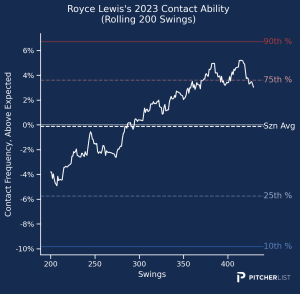
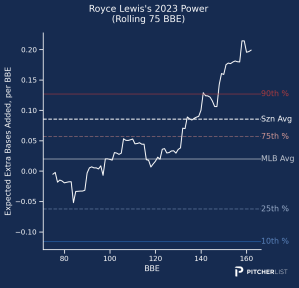
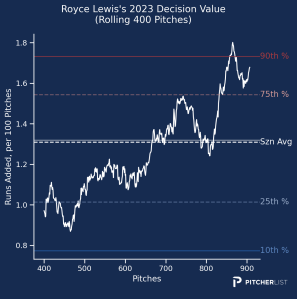
35. Oneil Cruz (SS, PIT) – Injuries robbed us of a Oneil Cruz breakout in 2023, but all of the pieces are there for 2024 to be the year. While the power hadn’t shown itself in that nine-game sample last season, the high walk rate and low strikeout rate were a continuation of the trends we saw at the end of 2022. Cruz is a player with 30-30 upside, and if he can show that he’s capable of even average decision-making, the 6’7 shortstop could be a top-20 hitter as soon as this year.
36. Nico Hoerner (2B/SS, CHC) – Those in deeper formats should probably move Hoerner up within this tier as stolen bases have a higher premium in those leagues, but even in shallow leagues, you are welcome to get excited about his 43 stolen bases in 2023. Fifteen is probably the hard ceiling for home runs for the slap-hitting middle infielder, but the excellent contact ability and the ever-present green light should allow Hoerner to come close to matching his 2023 stat line in 2024.
37. Jazz Chisholm Jr. (OF, MIA) – If healthy, Jazz could be a 30-30 type of player and could also give us improved counting stats if the Marlins continue to find good pieces for their lineup. Of course, health has been quite fleeting for the shortstop-turned-outfielder as he’s missed 205 games over the last three seasons. In addition, Jazz has a troubling 29.2% career strikeout rate and hasn’t given us any signs that it will change. The upside is indisputable, but the floor is incredibly low.
38. Mike Trout (OF, LAA) – He’s still Mike Trout, folks. Yes, he’s missed a lot of time over the past three seasons and wasn’t exactly a picture of health before then either, but his 134 wRC+ over 82 games in 2023 was the lowest single-season mark he’s posted in the big leagues since his 40-game campaign in 2011 (his rookie season). Being 34% better than average is bad for Mike Trout. Let that sink in.
39. Christian Yelich (OF, MIL) – Yelich appears to have figured out his chronic back issues after years of struggling and it led to his best season since 2019 as he hit 19 home runs, scored 106 runs, and swiped 28 bags with a .278 batting average and .370 OBP. The stolen bases might come down just a bit due to the aging curve, but another season with close to 20 home runs and 25 stolen bases is certainly in the cards, and the healthier back should help keep those ratios up a little higher than years past as well.
40. Cody Bellinger (OF, FA) – It was a second breakout for Bellinger in 2023 as he set career bests in strikeout rate, batting average, and stolen bases while putting up his most productive season since 2019. These dramatic turnarounds are hard enough to process on their own, but when they come with a career-worst barrel rate, hard-hit rate, and average exit velocity, it’s nearly impossible. I can’t ignore the actual results, but the concerning underlying numbers leave me quite skeptical that Bellinger can repeat without actually changing what he is as a hitter—something we aren’t asking anyone else in the top 40 to do.
Tier 6
41. Paul Goldschmidt (1B, STL) – The plate discipline is still there and Goldschmidt should still be locked into the heart of the Cardinals order, but age may finally be catching up to the 36-year-old after posting his lowest 162-game season home run total since 2016. I think there’s a good chance to clear 25 home runs in another full season (Goldy hasn’t missed more than 11 games in a season since 2014), but we should probably recalibrate our expectations for batting average and stolen bases as he posted a 27th percentile speed according to Statcast. I don’t think he’ll be a dud in the ratio department, but it isn’t easy to hit .300 when you start to slow down physically.
42. Adley Rutschman (C, BAL) – Rutschman finished as the second-best fantasy catcher in 2023 thanks to his positive contributions across the board (except for stolen bases, but he’s a catcher so that doesn’t count). He’ll be just 26 years old at the start of 2024 and Rutschman has already proven he has elite plate discipline and contact ability. His rolling chart for contact ability (below) shows that every single 200-swing sample we have for Adley was in the 90th percentile or better, which is a truly remarkable accomplishment for a backstop in his first full season in the majors.
Rutschman can’t challenge Smith or Contreras in the power department, but thanks to Rutschman’s everyday presence in the lineup (he had 76 more plate appearances than any other catcher in 2023), he has the highest floor at the position and more than enough upside to lead all catchers in every fantasy stat except for home runs and stolen bases.
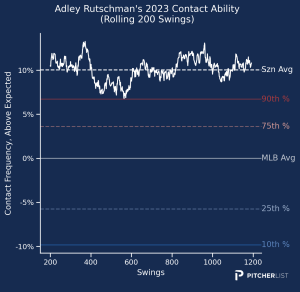
43. Christian Walker (1B, ARI) – Make it back-to-back seasons with over 30 home runs and finishing inside the top 35 hitters for Walker, who should continue to see a boost in counting stats thanks to Arizona’s rise to relevance. The Diamondbacks may not have the deepest lineup out there, but Carroll and Marte should get on base often enough to give Walker a good chance to get to 100 RBI again to go along with his 30-home run floor. The second straight season of a sub-20% strikeout rate also means that his batting average should be more neutral than it is negative.
44. Kyle Schwarber (OF, PHI) – Two seasons in Philly, two straight seasons of setting career highs in home runs (46 in 2022, 47 in 2023). It comes with a .200 batting average, unfortunately, but he’s second in home runs, seventh in runs scored, and ninth in RBI in all of baseball since the start of 2022. If you’re intentionally punting batting average or are in an OBP league, you can move Schwarber up to the middle or top of Tier 5, and if you’re punting batting average and stolen bases (which is a viable option in head-to-head category formats), you could argue he’s in Tier 4.
45. Will Smith (C, LAD) – Smith has finished among the top three catchers for three consecutive seasons thanks to his plus power and prime spot within the potent Dodger lineup. Thanks to three very consistent seasons, Smith is an easy player to project on the back of a napkin—22-25 home runs, 70-80 runs scored, 75-85 RBI, and a .260 batting average. That easily makes Smith a top-three catcher again, and while I think Adley has a higher floor because of the 20 to 30 extra points of batting average, you could argue Smith’s extra handful of home runs is more valuable to your team by this point in the draft.
46. William Contreras (C, MIL) – Seeing the strikeout rate drop to 20.6% in 2023 was a good sign, as the 29.3% and 27.7% he posted in 2021 and 2022 were big red flags that indicated there might be a low floor. Contreras only hit 19 home runs in his 141 games after hitting 28 in his 149 games across 2021 and 2022, and while it’s true his pull rate was down, his fly ball pull rate was about the same as 2022, so it’s a bit unclear to me why we saw the dip in power. There’s 25 home run power here, if not more, and the Brewers seem committed to playing him every day. I think some will place Contreras at the top of their overall rankings or projections based on the upside, and I wouldn’t blame you for it. These three top catchers are tough to separate.
47. CJ Abrams (SS, WAS) – For some reason, it took three full months before Washington realized that Abrams could steal bases and should maybe lead off for the Nationals. He stole just nine bags through the end of June, but after being promoted to the leadoff role in early July, he stole 16 bases that month, then 13 in August, and then nine more in September. Abrams has always been excellent at making contact, and in 2023 we finally saw some improvements in his decision-making ability. Abrams’ quick bat and aggression will always keep him from being an elite decision-maker by our metrics, but as long as he continues to make 90th-percentile contact, there’s a path toward 20 home runs and 50 stolen bases. The ratios will stink because he pops out a fair bit and tries to put too many balls in play, but his mix of power and speed will push him up a lot of boards in deeper and roto formats.
By the way, this ranking is for his head-to-head categories value, which is highly variable based on your specific need for steals, but even in a format that doesn’t care much about steals, Abrams is good enough to win that category for you on his own in any given week and that’s worth targeting.
48. Josh Jung (3B, TEX) – An injury interrupted an excellent rookie season for Jung, but he turned it around in time for the playoffs and looked every bit like the exciting power hitter we hoped for. The strikeout rate remains high due to his aggression at the plate, especially against breaking balls that escalated as the season went on (see below). The injury risk (he’s missed significant time in each of the last two seasons) and the exploitable swing aggression keep me from pushing up higher, but I wouldn’t be shocked if he approaches the top 30 on the Hitter List within a few weeks of play.
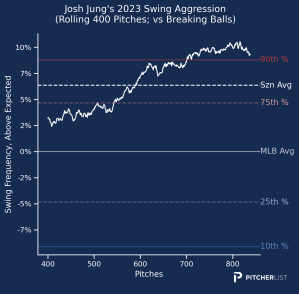
49. Alex Bregman (3B, HOU) – Bregman’s 2023 closely resembled his 2023 in just about every way, and I expect 2024 to be yet another re-run (not that it’s a bad thing). 20-25 home runs, 180-200 combined runs and RBI, and a .260/.365/.450ish line can be penciled in now and probably gone over in ink by next September.
50. Nick Castellanos (OF, PHI) – The strikeout rate went up fairly significantly (27.6%), continuing a trend that’s been going on for the last few seasons, but the production returned after Castellanos’s deeply disappointing 2022. There were ups and downs in 2023 (like May and July) that will make the floor a little bit scary, but the power is still there and he’ll continue to play every day for the Phillies so strong counting stats and 25 or more home runs should be there even if the batting average takes a tumble due to the strikeouts and inconsistency.

51. Bryan Reynolds (OF, PIT) – While I hoped that there’d be a bit more of a ceiling for Reynolds, he’s now put up three straight seasons of 24 or more home runs and has finished 14th, 24th, and 20th in the outfield in those campaigns. Counting stats are tougher to come by for Reynolds than other similar outfielders already on this list due to the fact he plays for the Pirates, but the floor is so high that it’s not too tough for me to squeeze Reynolds into my top 20 outfielders.
52. Nolan Arenado (3B, STL) – For the first time in his career, Nolan Arenado played over 135 games and failed to hit 30 home runs and drive in 100 runners in a single season. That’s the kind of career he’s had to date. Heading into his age-33 season, I can’t necessarily project a return to 30 home runs in 2024, but if the Cardinals can be at all better than they were in 2023 (and by all accounts, they should be), the counting stats and power should be more than enough to return to the top 50 or 60 hitters (he finished 71st in 2023).
53. Gleyber Torres (2B, NYY) – It’s difficult to foresee exactly where in the lineup the Yankees will put their most dependable player of 2023 with the addition of Soto, but the improved offense around him should mean that his counting stats will improve to at least some degree in 2024. I wouldn’t count on many more home runs (25) or stolen bases (13) this season, but if he brings the impressive improvement to his plate discipline back in 2024, it should keep those ratios high and give way to a significant boost to his runs scored and RBI.
Tier 7
54. Yandy Díaz (1B, TBR) – The 22 home runs were cool, but the elevated fly ball rate Díaz showed early in 2023 was an apparition, meaning those 22 reflect Díaz’s ceiling more than his baseline or floor. He should continue to score 90 or more runs and hit .300 or better at the top of the Rays lineup, though, so while a return to the top 30 hitters is a bit of a stretch, being in or around the top 50 hitters is quite feasible, and Yandy’s floor is exceptionally high thanks to his plate discipline and contact ability.
55. Josh Naylor (1B, CLE) – A drop in strikeout rate and groundball rate helped unlock more of Naylor’s potential, particularly when it comes to batting average. Runs may continue to be hard to come by with the extreme lack of depth in Cleveland (though the development of Bo Naylor and Manzardo could alleviate this to some extent), but 90-100 RBI should be in reach hitting fourth for this top-heavy lineup. Those counting stats plus about 20 home runs and a .285 or better batting average would be a nice addition to any fantasy squad.
56. Christian Encarnacion-Strand (1B, CIN) – The young slugger still has a lot of work to do on his decision-making, but the raw power started to shine towards the end of the season. Decision-making is a much more “learnable” skill than contact ability or power, so hopefully an offseason and more time with the big league club will get Encarnacion-Strand where he needs to be to unlock his peak 35+ home run power. 25-30 is a far more realistic goal for 2024 along with a batting average that stays above .260 (with the upside to be as high as .280), though, and this is roughly where that would land him.
57. Anthony Santander (OF, BAL) – Santander is unlikely to surprise us in 2024, but the improved Baltimore offense means his 30 home runs and .250 batting average should come with close to 100 RBI. He won’t steal many bases, but his floor and ceiling are pretty close together, making Santander an excellent choice for those who have already taken a few gambles on offense.
58. George Springer (OF, TOR) – Springer just put up his first ever 20-20 season at age 33, and while durability and age are negative factors to his value, he did put up a second consecutive season with at least 133 games and has at least 20 home runs in each of his last seven full seasons (even his injury-shortened 78-game season in 2021). Springer will be on top of a Blue Jays lineup that disappointed in 2023 and should rebound in 2024. 25 home runs, 15 stolen bases, and a .250-.260 batting average feel like a good baseline despite his advanced age along with 85 or more runs scored.
59. Nolan Jones (1B/OF, COL) – Jones was quite good for most of his 2023 debut (besides July), but he turned it on in September, posting a 16.4% walk rate, 21.1% strikeout rate, and a .349/.461/.651 line with seven home runs and 46 combined runs and RBI. The 21.1% strikeout rate is what stands out to me in this line, as Jones’s power was a known commodity from his prospect days and landing in Colorado made it even more likely that his power would play to some degree. If Jones can take a step forward in his decision-making against breaking balls, we could see a new gear to his game that looks more like his September line, but I’m guessing we don’t get quite that good of a result. I’m thinking something like 25 home runs, another 20 stolen bases, and a volatile (but not necessarily bad) batting average with good-not-great counting stats on a bad Rockies offense.
60. Spencer Torkelson (1B, DET) – The ratios continue to lag, but the power was on display in 2023 as Torkelson hit 31 home runs with 27 of those dingers coming on or after June 4th (106 games, which is a 41 home run pace over 162 games). Tork’s high flyball rate will likely keep his average from being more than neutral in spacious Comerica Park, but with this kind of power, he just needs to hit closer to .250 to unlock his fantasy potential. Some additional help around him would be nice, such as a healthy Greene and a free agent or two, as it would boost his counting stat potential. I love looking at this rolling chart of his power—it takes a special player to add more than double the number of expected extra bases for almost 100 batted balls.
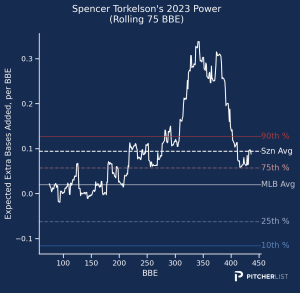
61. Vinnie Pasquantino (1B, KCR) – Injuries cut his 2023 far too short, but with Pasquantino’s excellent plate discipline creating a high long-term floor for his ratios, the only question is how much power he can find in the major leagues. He has 19 home runs so far in his 133-game major league career, and while he did hit 28 home runs across triple-A and the majors in 2022, I think asking for more than 22-25 is asking for too much from Vinnie P, especially if the trend in the chart below continues. Assuming he returns to being a plus decision-maker, Vinnie P should be a high-floor, moderate-ceiling first baseman, which sets him apart from Torkelson and Casas who have higher ceilings thanks to their power but much lower floors due to their contact issues.
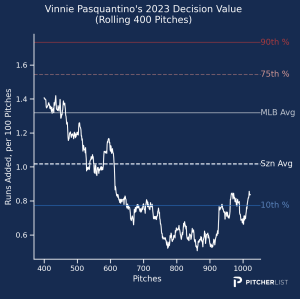
62. Triston Casas (1B, BOS) – Casas hit his stride in the second half, hitting 15 home runs while slashing .317/414/.617 with just a 23.7% strikeout rate. There’s 30+ home run power with Casas, and he was a strong decision-maker for all of 2023. If Casas can keep the Red Sox comfortable enough to start him against lefties, he should get enough plate appearances to get to 30 home runs and 90 RBI, but his extremely passive ways and his swing-and-miss issues against lefties present just enough of a risk that I have him third among the three first basemen in this tier. In truth, though, you could shuffle these three up any way you want and you’d have some good arguments to justify it.
Tier 8
63. Lane Thomas (OF, WAS) – Thomas exceeded my expectations for him in just about every category, and in the case of home runs and steals, he did it by almost double. While his quality of contact did improve to a degree and he did start pulling the ball significantly more, it doesn’t explain the improved numbers. If it did, our Pitcher List expected stats (which take into account batted ball direction) would show something better than a .237 xAVG and .446 xSLG. While I do think a 20-20 season is within reach and accept that none of his numbers seem especially dubious, I’m still a bit skeptical that Lane Thomas can wind up in the top 50 hitters. Top 60 or top 75 should be doable, though, and his floor should keep him from falling out of the top 100 (which is not true for many hitters in the tier below).
64. Ha-Seong Kim (2B/3B/SS, SDP) – Another player who exceeded all reasonable expectations in 2023, Kim wound up at the top of the order and slapped his way into 17 home runs, 38 steals, and 84 runs scored. The stolen base upside is pulling him up these rankings, and his strong plate discipline should help Kim recreate something close to his .351 OBP from 2023. I’m not sure Kim can flirt with 40 steals again, but even if he only gets 30, he should be well worth this price.
The trade of Soto may have a weird effect on Kim as it will open up the top of the lineup. The Padres could move Kim to the number one or two spot as his contact-oriented approach is ideal for those roles, but San Diego is so right-handed heavy at this moment that they could also choose to use Cronenworth in that role and move Kim to fifth or sixth. Kim’s skillset is best for fantasy when he’s batting first or second, though hitting lower isn’t a bad thing for his RBI totals and he should get plenty of opportunities to run in either situation.
65. J.T. Realmuto (C, PHI) – It wasn’t a bad season for Realmuto by any means—he did steal 16 bases and hit 20 home runs—but for the first time in what feels like forever, he finished outside the top five catchers in 2023. The rise of several young catchers combined with a bit of a down year in terms of batting average and contact led to his lowest full-season RBI total since 2016 (63) were the most likely culprits, and while I do think the batting average and/or strikeout rate can rebound a bit, it’s hard to imagine Realmuto finishing in the top three at the position. Fourth feels about right.
66. Xander Bogaerts (SS, SDP) – Bogaerts rebounded nicely from his awkward 2022 with 19 home runs and 19 stolen bases in his first season with the Friars while maintaining strong ratios. I expect Bogaerts to lead off in San Diego following the Soto news, which means he may struggle to clear 60 RBI, but on the bright side, he should score 85 or more runs in front of Tatis and Machado despite the loss of Soto.
67. Seiya Suzuki (OF, CHC) – Suzuki is now two-for-two in slow starts and strong finishes here in the US, and in each case, we have at least a somewhat compelling reason for the slow start (adapting to the US in 2022, and coming back from injury in 2023). A Suzuki that doesn’t start poorly could probably hit 25 home runs, steal 10 bases, and slash .280/.360/.485, and I’m willing to buy into that upside at least one more time.
68. Matt McLain (2B/SS, CIN) – McLain won’t repeat his .290 batting average without a lot of batted ball luck (he’s not the type of hitter who can hit almost 25% line drives like he did in 2023), but there’s a good enough power and speed combo to give McLain a shot at 20-25 home runs and 15-20 steals for the Reds along with above-average counting stats. The decision-making and contact ability were progressing in the wrong direction, which raises some alarm bells, but to me that gets offset by the strong debut last season, at least to some degree. It’s also why I’m much lower on him than his current NFBC ADP.
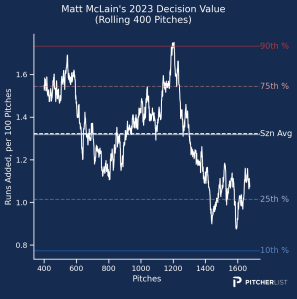

69. Jordan Walker (OF, STL) – The highly-hyped prospect didn’t have the debut we hoped for, but to be fair, a 116 wRC+ as a 21-year-old is nothing to sneeze at. A demotion to the minors in May and summer slump were disappointing (and not entirely his fault), but it was good to see Walker rebound late in the season, slashing .302/.376/.497 from August 9 to the end of the season that very importantly included almost as many fly balls as grounders. I was encouraged by that growth because it’s the secret to unlocking his power potential, and also by the fact that Walker was not at all phased by major league breaking balls—a very common issue that you’ll hear me talk about throughout these rankings. 2024 could very well be the breakout year for Walker.
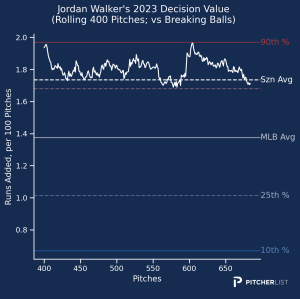
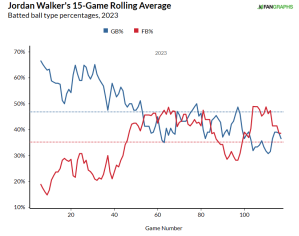
70. Ketel Marte (2B, ARI) –Marte rebounded in a big way in basically every category we use for fantasy and now finds himself batting near the top of the order for a team that actually can score runs. 25 home runs is probably the high end of what to expect in 2024, but the 94 runs scored and 82 RBI from 2023 shouldn’t be much different from his 2024 totals. Slap a .275 or better batting average and a .350 or better OBP on it, and you’ve got a solid second baseman.
71. Luis Arraez (2B, MIA) – Arraez is at his best in points leagues where you get credit for all of those singles even if they don’t drive anyone in, but 80 runs scored and 60-70 RBI with a batting average that can be anywhere from .310 to .350 has value even when it comes with no speed and only 10 home runs. Arraez isn’t a fit for every team build, though. For example, if you’ve already drafted three or four hitters who are likely to hit .280 or better, Arraez’s impact to your bottom line may not quite be worth a pick in this range. If you instead took a few guys who either will or could tank your batting average (De La Cruz or Schwarber come to mind), Arraez can move the needle significantly due to the number of plate appearances he should get every week and the fact that he’s the odds-on favorite to win the NL batting title.
72. Josh Lowe (OF, TBR) – Lowe started hot, got very cold, and then was hot again, which makes projecting for him a frustrating endeavor. I think the 20 home runs seem about right based on his minor league track record and scouting grades, and the Rays are so aggressive on the base path that 32 stolen bases are certainly attainable. The strikeout rate is the number to watch, as the prolonged slump for Lowe was closely tied to strikeout issues over the summer. Lowe was never a good decision-maker at any point in 2023, but he did manage to improve his ability to make contact towards the end of the season with specific improvement against breaking pitches (see below), and if that continues then we can expect another strong season. If he regresses with the contact against breakers, though, it could be a bumpy ride with a low floor.

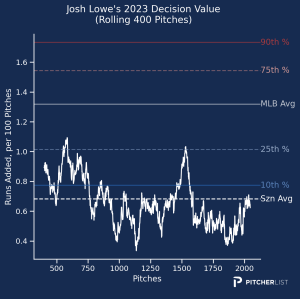
73. Dansby Swanson (SS, CHC) – Swanson hit more ground balls than usual in 2023 and it led to slightly lackluster numbers in home runs and batting average, but he remained a dependable player who can accumulate counting stats due to his durability and place in the lineup. It’s hard to say what the Cubs lineup will look like on opening day due to the number of players they’ve been attached to this offseason, but he should stay somewhere in the top six spots and that’s all Dansby needs to get another 160-170 combined runs and RBI along with 20-25 home runs and close to 10 stolen bases.
74. Anthony Volpe (SS, NYY) – The fact Volpe played 159 games and knocked 21 home runs with 24 steals made his 2023 a success even if it fell short of the lofty expectations of prospect chasers. Expect Volpe to improve on his counting stats and ratios in his second full season with an improved supporting cast, and if he can dig his way out of the bottom of the order, he could become a top-50 hitter before you know it. There is, of course, the risk that the strikeouts don’t come down and he continues to post subpar ratios that force the Yankees to bury him in the lineup, but that would be lame and not fun so I’m trying not to think about it.
Tier 9
75. Andrés Giménez (2B, CLE) – Like many Guardians, Giménez got off to a slow start in 2023, particularly in the power department as he hit just three home runs in his first 61 games along with way too many grounders and pop-ups. Following that skid, things did pick up as Giménez hit 12 home runs and stole 23 bases over the remaining 92 games, which would have been a 20 home run, 40 stolen pace over 162 games.
I don’t buy into Giménez hitting 20 home runs with any regularity, but 15 is a reasonable baseline, and 30-40 steals in the current environment are also repeatable thanks to his aggressive manager. There also should be improved counting stats in 2024 as he cements his role as the number two hitter in front of Ramirez and Naylor, and that will help him return more value in 2024.
I realize I’ve used 162-game averages a few times so far in this article, but please don’t mistake that as a way to project a player. Instead, it is a way to put smaller samples into an easy-to-compare context to highlight just how good or bad the sample would have looked over a full season.
76. Cedric Mullins (OF, BAL) – With Henderson usurping the leadoff role from Mullins, the range of outcomes for the speedy outfielder is now much wider than in years past. Mullins finished well outside the top 100 hitters in 2023 thanks to a poor batting average, injuries, and then being forced into a platoon to end the season.
Mullins will get another shot at full-time plate appearances in 2024, though it will likely be lower in the order than 2021 and 2022 (maybe sixth or so) and the leash will be short due to the up-and-coming outfield talent Baltimore has in the minor leagues. If Mullins can solidify his role in the lineup, there should be a path to 20 home runs and 30-35 steals that would put him inside the top 50. If he isn’t able to get into a groove, though, there’s the risk that he will post yet another finish outside the top 100, and possibly even outside the top 150.
77. Marcell Ozuna (UT, ATL) – Ozuna set career highs in home runs and RBI while also raising his batting average by over 50 points from 2021 and 2022. It’s an extreme change after looking like he was toast for two seasons, and it’s not easy to explain using pure statistics. Ozuna’s health has been an issue in recent years, but the upside of a healthy and slugging Ozuna in the Atlanta’s lineup is hard to ignore.
78. Bryson Stott (2B, PHI) – The spray-hitting second baseman broke out in a big way in 2023 by hitting 15 home runs and stealing 31 bases with a high batting average for the Phillies. He finished as the 60th-best hitter for fantasy purposes in standard leagues, though I’m not sure he can be quite so successful in 2024. The 15 home runs seem about right, but the 31 stolen bases are more than he had in his entire career up until 2023. The new rules give players a boost, but this was a little extreme. I’m envisioning something closer to 20 steals (which is still a big jump from his previous single-season record of 14). Put that together with good ratios (.270 average with a .325 OBP, perhaps?), and you have a hitter who is definitely in the top 100 and has a shot at approaching the top 50.
79. Nathaniel Lowe (1B, TEX) – The home runs and ratios went back to their 2021 levels, but on the plus side, so did the walk rate. Lowe should keep batting in the heart of the Texas lineup and get plenty of runs scored and RBI to go with 17-20 home runs and a .265 batting average. Those in OBP and points formats can probably move him up to the bottom of the previous tier due to the walks. It may not be exciting, but the steady and solid production Lowe provides should be more than enough to finish inside the top 80 hitters as he did in 2023, even without the big power we saw in 2022.
80. Yainer Diaz (C, HOU) – With the manager already declaring Diaz as the head backstop heading into 2024, Diaz has the potential to finish as a top-five catcher thanks to his blend of hit tool, power, and opportunity. It wouldn’t take much for Diaz to hit within the top five spots in the order for the Astros (Roster Resource has him sixth, with Abreu in front of him), and even if he only plays in 110-120 games, Diaz could approach 25 home runs and 75 RBI. Diaz’s quality of contact data from Statcast supports the high batting average we saw. This combination of talent and situation has me placing Diaz in a tier of his own at catcher and as my clear number five.
81. Teoscar Hernández (OF, FA) – It was a bumpy ride at times, but the free-swinging Hernández hit his way into a solid season in Seattle that saw him finish as a top 25 fantasy outfielder and top 60 fantasy hitter. Teoscar’s aggressive approach leaves him incredibly prone to hot and cold streaks, and those streaks defined his 2023 for me as he repeatedly oscillated between being a must-start and a must-sit sort of player.
Hernández could move up a tier if he finds an ideal landing place (friendly park for right-handed power, strong team around him, etc.), but this ranking is more on the conservative side and assumes he lands in a more neutral environment and/or continues to see his contact ability regress from years past.
82. Riley Greene (OF, DET) – Greene’s injury, which forced him to miss more than a month of action, could not have come at a worse time as he was absolutely on fire at the time, hitting .365/.435/.573 last May before going down. Greene’s power and speed aren’t overwhelming for fantasy, but I still believe he can get to 20 home runs and double-digit steals with an excellent batting average if he stays healthy with the upside to do even more.
83. Jake Burger (3B, MIA) – Many have probably noticed that Burger’s strikeout rate was markedly better after moving to Miami, but as the rolling chart below shows, he started making this change well before the trade. Burger’s floor is very much tied to how often he can make contact when he swings due to his immense power, and if the strikeout rate improvement sticks, then this ranking will turn out to be far too low. There’s reason to believe he can hold on to it though, as he showed exceptional decision-making skills against breakers and improved against fastballs as the season went on. If he can keep making good decisions against the breaking balls and be even average against fastballs, he could be a force.
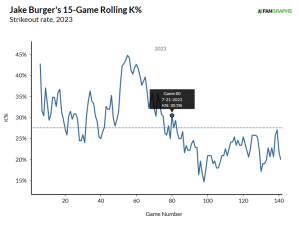
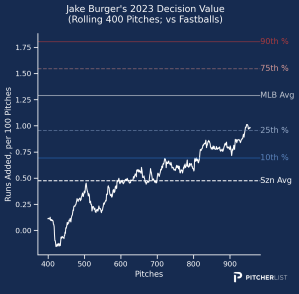
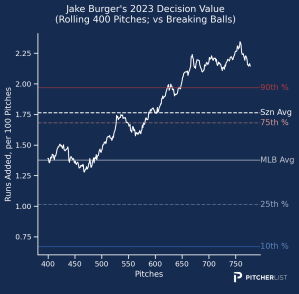
84. Max Muncy (3B, LAD) – 2023 was the first time Muncy drove in over 100 runners, and his 36 home runs tied a career high he had set in 2021. The batting average will always stink and his OBP is more neutral than it is positive these days, but another year as the primary third baseman for the Dodgers gives Muncy a top 50 upside. Being 33 years old and never having played in more than 144 games in a season is a bit of a bummer, as is losing the first and second base eligibility he’s had in years past. That said, the replacement level in standard leagues should make covering the 20-30 games he misses a breeze.
85. Jorge Soler (OF, FA) – It was Soler’s best season since the rabbit-ball era of 2019 thanks to good health, a career-high fly ball rate, a significantly reduced pop-up rate, and one of the best season-long strikeout rates of his career. Soler continues to hit the ball exceptionally hard on a very consistent basis, so he’s certain to find a team that wants him to play every day.
The keys to Soler’s 2024 will likely be team context (ballpark, supporting cast, etc.) and whether he can stay healthy after missing huge chunks of time in multiple prior seasons. If Soler wasn’t heading into his age-32 season with a long injury history, I’d likely have Soler at least one or two tiers higher than this. He could also jump if he signs with a powerful offense (like the Dodgers).
86. Eloy Jiménez (OF, CWS) – Health continues to evade Eloy as he played in just 120 games in 2023. From a talent perspective, he should be a .280+ hitter who hits 30 home runs and drives in 90 runners regularly, but the sheer number of injuries he’s suffered over the last three seasons makes that kind of projection much harder to imagine. Jiménez’s upside keeps him in my preseason top 100, but I’d need to feel pretty good about my power and consistency in the outfield to consider drafting him where he’ll likely be going.
87. Brandon Nimmo (OF, NYM) – Nimmo finished just inside the top 70 hitters last season thanks to a significant power boost tied to an elevated fly ball rate and also a career-high in plate appearances. He hit the ball harder as well, raising his average exit velocity by over two ticks. There’s still some risk on the injury front as Nimmo enters his age-31 season having missed significant time in 2017, 2019, and 2021, but if you believe the almost one-to-one groundball to flyball rate will stick in 2024, then Nimmo should be moved up a tier. I’m a bit skeptical on that, but not so skeptical that I’m uninterested in Nimmo as a third outfielder in 12-team leagues.
88. Isaac Paredes (1B/3B, TBR) – I have been on board for quite some time due to the hit tool and the way the Rays have used that skill and turned it into home runs. Despite the lower batting average, Paredes remains a guy who is excellent at making contact, and as long as he has an everyday role, I’m all in on another 28-30 home run season for Paredes and another 90+ RBI. I also believe he can repeat the .250 batting average due to his ability to avoid strikeouts and his willingness to take a walk rather than chase bad pitches.
Paredes happens to be an example of how expected stats can be misleading for players with specific skill sets. Baseball Savant’s expected batting average does not take batted ball direction into account because it is often fluky and year-to-year pull rates are not usually that sticky. That said, some players do make specific, intentional changes to their batted ball profile (like Paredes has), and it allows them to overperform those expected stats quite significantly.
Tier 10
89. Jarren Duran (BOS, OF) – The trade of Verdugo makes Duran the obvious pick to lead off for Boston, a role he excelled in last season as he hit .319/.350/.547 with 25 runs scored and 23 extra-base hits while going 12 for 13 in stolen base attempts over just 36 games. Injuries and inconsistency threw his train off the tracks at times, but a healthy Duran is more than capable of hitting 15 home runs and stealing 30 bases in 2024. He’s missed time with injury in two of the last three seasons and had two particularly brutal cold stretches in May and August, but Duran is more than worth taking a chance on in the middle rounds of a draft.
90. Alec Bohm (1B/3B, PHI) – 2023 is probably the peak of what Bohm can be: 20 home runs, 97 RBI, and a .274/.327/.437 line. At one point in time, Bohm was considered a power prospect who could hit 25-30 home runs, but his time in the majors has seen him shift into being a contact-oriented hitter with a subpar barrel rate and a low fly ball rate. He finished inside the top 75 hitters thanks to the boosted RBI, and if Turner, Harper, and Castellanos can look like they did in the second half of 2023 he could flirt with 100 RBI again. That said, Bohm’s limited power (especially against right-handed pitching) makes such a high total tough to reach and makes him more of a high-floor player than anything else.
91. Thairo Estrada (2B/SS, SFG) – Despite missing over 40 games in 2023, Estrada managed to hit just as many home runs and steal a few more bases than he did in 2022 while also hitting for a better average. Estrada should again find himself at or near the top of the Giants lineup, but as it currently stands, the Giants offense will not create many run-scoring opportunities. 15 home runs and 25 steals could be there, but the counting stat totals aren’t going to be pretty unless the Giants make significant changes to the lineup and Estrada’s health risk exacerbates the counting stat issue even more.
92. Salvador Perez (C/1B, KCR) – Perez is a two-category catcher at this phase of his career as he provides home runs and RBI with extreme reliability as he tries not to hurt you in runs scored and batting average. His 22-25 home runs and 70-80 RBI are about as bankable as they come if he plays at least 120 games, though at some point we have to wonder when the extreme mileage on Sal’s tires start to impact his ability. His barrel rate, hard-hit rate, and average exit velocity were down from his 2021-2022 numbers, but they were still in line with numbers from before that stretch so I don’t think we should be concerned yet.
93. Ian Happ (OF, CHC) – Happ gets a boost in OBP leagues thanks to his double-digit walk rates, but even in standard leagues his 20-22 home runs and 12-15 steals should make an impact, especially since they come with over 80 runs and 80 RBI as long as he’s healthy and the Cubs can look anything like the 2023 version of themselves. Happ is mostly just an accumulator who provides everything except batting average, and if you’re in a deeper league or are at a place in your draft where you need a safety net in the outfield, Happ is your guy.
94. Chas McCormick (OF, HOU) –McCormick was another player I was very skeptical of last season due to his poor zone contact rate and his inflated line drive rates around the middle of the season, but to his credit, McCormick continued to produce (albeit to a lesser extent) when the line drive rate started to return to normal, hitting nine home runs and stealing eight bases over his last 50 games.
McCormick truly shines against lefties, posting a 177 wRC+ against them in 2023 and a 163 wRC+ against them over his career while being merely average against right-handed hitting. That weakness to righties caps McCormick’s upside a bit, but his strong defense and 2023 breakout should help him eclipse 120 games played for the first time in his big league career while giving him a path to a 20-20 season. The batting average is a question mark and any prolonged slump could lead to a platoon, but as long as he’s in the lineup the power and speed should be there.
95. Masataka Yoshida (OF, BOS) – Yoshida’s season probably felt worse than it was to those who rostered him due to the complete collapse of his power in August and September. He hit just two home runs over his final 33 games, and part of his descent was likely related to his increased aggression and worsening decision-making as the season wore on. On the plus side, while his contact ability faded it stayed safely above average and that tool plus some lessons learned over the offseason could lead Yoshida to 20 home runs, double-digit steals, and a batting average that flirts with .300. If it doesn’t, the floor should be high enough to keep him near or around the top-100 hitters unless the bottom completely falls out.
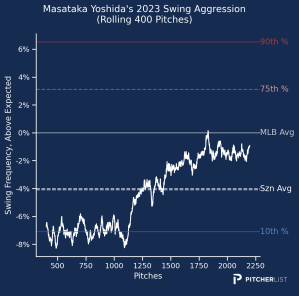
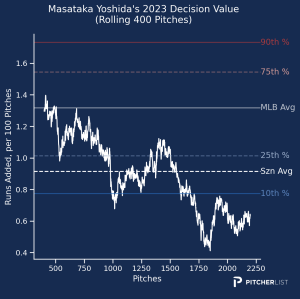
96. TJ Friedl (OF, CIN) – It was a breakout campaign for Friedl as he was able to stay healthy and with the big league club for a (mostly) full season’s worth of plate appearances. Friedl dramatically outperformed his expected stats in 2023, beating his Baseball Savant xwOBA by 63 points and his Pitcher List xwOBA (which includes batted ball direction) by 57 points with most of the difference coming in his power numbers. That kind of overperformance makes me doubtful that Friedl can replicate his 2023 performance in any category besides runs scored (as he projects to lead off for the Reds).
A more realistic baseline would probably be 15 home runs, 80-90 runs scored, and 20-22 steals, with a significant drop in ratios that are more likely to resemble the .240/.314/.436 he posted in 2022, which is far more inline with what his expected stats have shown at the major league level.
97. Spencer Steer (1B/3B/OF, CIN) – Steer’s first full season in the big leagues went far better than anyone could have expected, with 23 home runs, 15 steals, and 160 combined runs and RBI with a .271/.356/.464 line. His average tailed off towards the end of the season, in part because pitchers started to challenge him less with hittable pitches (particularly breaking balls), but Steer responded well by showing he could make contact with the more difficult pitches.

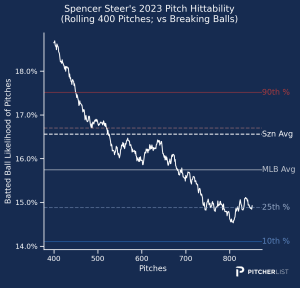
I’d be surprised if Steer repeated his 15 stolen bases as he never stole more than eight in a single season in the minor leagues (eight to 10 is a better starting point), but Steer shouldn’t have an issue clearing 20 home runs again with strong counting stats and his hit tool is good enough to post above-average ratios.
98. Ke’Bryan Hayes (3B, PIT) – Health has been an issue for Hayes in each of the last three seasons, but it was great to see Hayes hit those 15 home runs in 124 games as it was more than he’d hit in the 232 games he played in 2021 and 2022. His aggressive approach will likely keep his OBP low, but the growth in Hayes’s power was real, and if he can have some better luck on the health side, we could see a 20-20 season. Sure, it’ll be on a bad Pirates offense that caps his counting stat totals, but it’s still pretty exciting.
99. Noelvi Marte (3B, CIN) – Marte flashed speed and a bit of power in his brief 2023 debut and he should have a clear path to being the everyday third baseman for the Reds in 2024. Marte was considered a top 20 prospect as recently as 2022, and his pedigree reinforces the notion that he could put up something close to a 20-20 season with above-average ratios. Marte has only played 74 games above double-A which makes any projection risky, but if you need an upside play at the hot corner, Marte makes for an intriguing pick.
100. Jackson Chourio (OF, MIL) – Chourio looks like the new center fielder in Milwaukee and is set to make his Major League debut less than a month after his 20th birthday. Chourio is bursting with raw power and speed and is widely considered one of the top three prospects in baseball, plus he took big steps forward with his strikeout rates after a bit of a rough start in low-A. Chourio’s high groundball rates in the minors may make turning the raw power into home runs a challenge in the early going (Jordan Walker had similar issues in the minors if you need a comparison), but if Chourio can work it out, he could exceed 20 home runs and 20 steals in his rookie campaign.
101. Lars Nootbaar (OF, STL) – Injuries once again limited Nootbaar to fewer than 120 games in the big leagues, but he still managed to show the power, speed, and on-base skills that caught our attention in 2022. Nootbaar looks like a good fit for the top third of the lineup, and if he can seize that opportunity, we could be looking at a23-25 home runs, 150-160 combined runs and RBI, 13-15 steals, and solid ratios. Those are all dependent on health and lineup position, though, and Nootbaar has yet to show consistency with either, but the upside is very real.
102. Rhys Hoskins (1B, PHI) – The 30-year-old slugger missed all of 2023 with a knee injury and saw the Phillies decline his option for 2024, making him a free agent for the first time in his career. We know a healthy Hoskins is capable of 30 home runs with a .245 batting average, but injuries have now been major issues in two of the last three seasons and it’s unclear what kind of opportunities he’ll get on the free agent market. If he lands in a good situation and looks healthy in Spring Training, except Hoskins to jump up significantly in these rankings, but until then, the health risk and uncertain role will hold him back.
103. Zack Gelof (2B, OAK) – I was quite harsh on Gelof during the regular season due to his weird swing, his poor zone contact numbers, and his inflated line drive rates. While Gelof did improve his zone contact to an extent as the season went on, my lack of faith in players who miss more than 20% of the pitches they swing at in the zone remains as steadfast as ever.
Gelof’s mechanics aren’t enough to prove to me that he can sustain a line drive rate close to 30% as he had for most of the season in 2023, but I do admit the power is legitimate and the A’s will play him near the top of the order every single day. 20 home runs and 20 stolen bases are very much in play for Gelof (and 25 home runs wouldn’t shock me either), but the strikeout rate and luck regression will likely bring that batting average closer to .230.
Tier 11
104. Evan Carter (OF, TEX) – You can’t ask for a much better debut than what Carter showed us last season. In 40 games between the regular season and playoffs, his batting average was over .300, his OBP was over .400, and hit six home runs with six stolen bases. He’s fast enough to steal north of 20 bases given the opportunity. I am skeptical, though, that Carter can hit more than 15 home runs in a season, and the elevated strikeout rate will need to improve to project a batting average better than .250.
There’s always a lot of risk when talking about a guy with just 48 games above double-A, but it’s hard not to be excited about what Carter can bring to the table.
105. Kerry Carpenter (OF, DET) – Carpenter is a power-first outfielder who could hit 30 home runs in a full season, though his vulnerability to left-handed pitching makes him a platoon risk. I think the batting average will be around .260 and he’ll get plenty of counting stats when in the lineup, so all that’s left is for him to start in 140 or more games to exceed this ranking.
106. J.P. Crawford (SS, SEA) – Crawford’s 19 home runs were more than he had in the prior three seasons combined (covering 358 games) and the most compelling narrative relates to changes he made over the offseason with Driveline. Crawford did manage to get the ball in the air more and did pull the ball more in 2023 than in any other season as a Mariner, and the elevated walk rate helped him score 94 runs. Crawford should be the primary leadoff man again in 2024, and even if the power takes a bit of a step back, the floor is extremely high thanks to his ability to make contact and take walks. This isn’t a big upside play, but he’s easily the safest bet in this entire tier.
107. Christopher Morel (OF, CHC) – Morel is still without a regular position due to his subpar defensive skills, but his raw power suggests he could hit 30 or more home runs in a season if he managed to make contact on a more consistent basis. Morel’s strikeout woes are well-documented, though, and his decision-making skills declined as the season went on (see below). The low contact ability means Morel needs to make good decisions at all times, and until he can pull that off, he’ll remain an extremely volatile player.
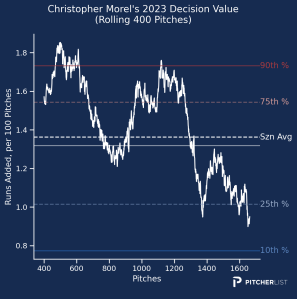
108. Daulton Varsho (OF, TOR) – It was a disappointing first season in Toronto as he fell short of expectations in almost every category. A big part of the explanation is the 19% pop-up rate, the second-worst mark in the league and almost double the rate he posted in 2022. Our PLV metrics indicate he was incredibly aggressive against fastballs to start the season, though it improved as the season went on which is also reflected in his decision value against those fastballs (though it’s worth noting that his pop-up rate was worse at the end of the season, so decision-making against fastballs didn’t cause that specific problem).
Varsho should be a 20-20 outfielder in Toronto and his counting stats should improve naturally by rebounds from Gurrero Jr. and Bichette, though the batting average will stay in the basement unless he makes better decisions against fastballs and/or cuts down on the pop-ups.
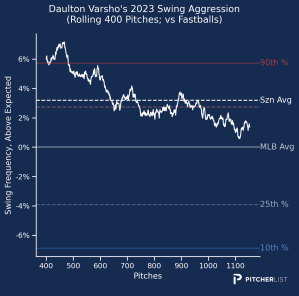
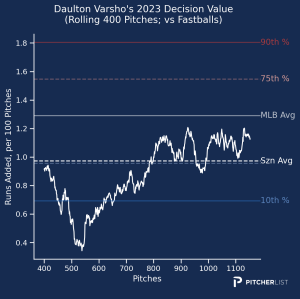
109. J.D. Martinez (UT, FA) – J.D. found his power again last season for the Dodgers, hitting 33 home runs in just 113 games and driving in 103 runners. He’d deserve a higher ranking than this if we knew he’d be heading back to LA, but with uncertainty on his landing spot, we have to hedge our bets a bit for now.
110. Jeimer Candelario (1B/3B, CIN) – Candelario could not have asked to be dropped into a better position as he’ll be hitting in the middle of the order for the up-and-coming Reds with a secure, everyday role. He may not repeat the eight steals he had in 2023, but look for Candelario to match or beat his home run, runs scored, and RBI totals in Cincinnati and push for a finish inside the top 100 hitters. His ceiling and floor probably aren’t that far apart, but it’s of high enough quality that we don’t mind the lack of explosive upside.
111. MJ Melendez (C/OF, KCR) – Melendez finally turned it on towards the end of the season, hitting .286 with eight home runs over his last 44 games. Counting stats won’t be easy to come by in Kansas City, but there’s enough raw power in his bat that Melendez could get to 20 or more home runs in his everyday role and score 80 runs. The batting average won’t be better than .240, but in leagues where he’s still eligible at catcher, there’s plenty of value.
112. Willson Contreras (C, STL) – After a rocky start in St. Louis, Willson hit 20 home runs and chipped in over 120 combined runs and RBI for the fourth time in as many 162-game seasons. I see no reason Contreras can’t do that again, and that kind of floor is extremely rare at catcher.
113. Cal Raleigh (C, SEA) – It’s safe to expect that Raleigh will hit home runs with a low batting average once again in 2024, and the fact that Seattle also lets him DH when he’s not behind the plate means that he’ll get more plate appearances than the usual catcher as well. Raleigh can be streaky due to his power-only approach, but as long as you have the patience to ride out the bad times, he makes for a solid fantasy catcher.
114. Lourdes Gurriel Jr. (OF, ARI) – If you read the Hitter List over the last two seasons, then you know that I struggle to know what to do with Lourdes Gurriel. The dizzying highs and terrifying lows we get from him throughout a season make Gurriel a player you can’t merely plug into your lineup and forget about, and the ups and downs don’t correlate with standard splits (like righty/lefty or home/away).
Gurriel enters 2024 as a free agent, and while he certainly could hit 20-25 home runs with a .270 average (this would be a high-end projection for sure), his wide range of outcomes has me pushing him down my list unless he lands in an ideal situation somehow.
115. Edouard Julien (2B, MIN) – In his very first exposure to the majors and being only 24 years old, Julien showed he is and will likely continue to be among the best decision-makers in the league (see below) and can punish fastballs.
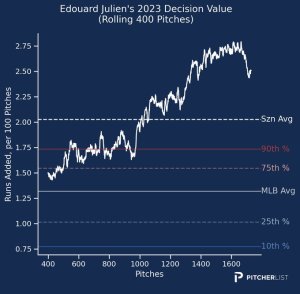
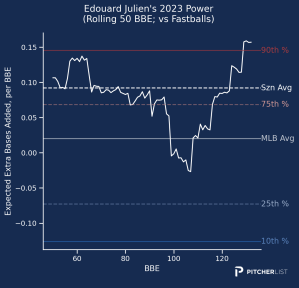
This is an excellent starting point to launch a successful 2024 season, though it’s worth noting that there are weaknesses in how he performs in both contact and power against breakers and offspeed pitches. That particular weakness isn’t unique to Julien, though, as many young players struggle to adjust against how well major league pitchers can use these weapons compared to minor leaguers. I believe there’s room for Julien to learn how to deal with these pitches, and it could lead to 20 home runs with 90+ runs scored if he can stay at the top of the Twins’ lineup.
116. Jackson Holliday (SS, BAL) –I struggled with how to rank Holliday, who is generally considered to be the top prospect in the game after rising from low-A to triple-A in 2023 at age 19 while showing excellent plate discipline, contact ability, and speed. Holliday only managed 12 home runs in his journey through the system, but the 30 doubles suggest there’s more pop than the home run total indicates. This ranking assumes Holliday wins the starting shortstop job out of camp, which opens up the opportunity to hit 15 home runs and steal 20 bases with plus ratios. There’s an obvious risk in projecting a 20-year-old rookie with just 52 games above high-A, but the hit tool, speed, and power combination should be exciting to watch.
117. Tyler O’Neill (OF,BOS) – Another year, another rash of injuries and poor performance from O’Neill despite possessing plus power and speed. O’Neill enters 2024 as hyped as he’s ever been now that he’s been traded to a Red Sox team that doesn’t have any significant threat to his playing time (other than O’Neill’s own body). Fenway could be a boon to O’Neill’s power numbers as it provides even greater incentive to pull the ball. Additionally, the chart below shows growth in his decision-making that could help him keep that double-digit walk rate and lowered strikeout rate in 2024. The extreme injury risk and erratic performance in the last few seasons make it hard to rank him higher, but if you want potential, there’s evidence there to support its existence.
As a caveat, those in deeper formats who can’t easily replace an outfielder should move O’Neill down your list by at least one or two tiers, if not more. This ranking only works in standard 12-teamers because whiffing on an outfielder at this stage of the draft doesn’t do any long-term damage.
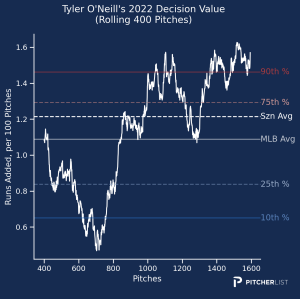
118. Francisco Alvarez (C, NYM) – Alvarez has the upside to be, well, Cal Raleigh but with a better batting average, but unlike Raleigh, he doesn’t currently have the luxury of being the DH when he’s not catching. If Alvarez can find some consistency in 2023, we could see him get those DH plate appearances, but until then, he’s an upside power-hitting catcher.
Tier 12
119. Andrew Vaughn (1B, CWS) – Vaughn has increased his home run, runs scored, and RBI totals in each of his three major league seasons, but that’s about where the good news ends for those who have waited for Vaughn to justify his former standing as a top 20 prospect.

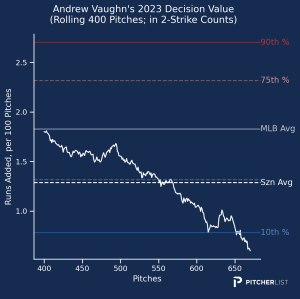
Vaughn is quite good at making contact and has slightly above-average power, but his rising aggression in 2023 led to lots of bad swing decisions, especially in two-strike counts. Unless he can find a way to make good decisions on a more consistent basis, the Vaughn we’ve seen in 2022 and 2023 is probably the Vaughn we’re going to continue to get. I’m holding out hope that there’s one more level to his game, but if we don’t see it in 2024, I’ll finally be ready to completely move on.
120. Taylor Ward (OF, LAA) – The decision-making went from average to incredible in 2023, and Ward showcased a strong ability to make contact with flashes of above-average power. Injuries and inconsistency foiled him for a second consecutive season, but like Vaughn, I’m willing to get back on the saddle one more time to see if we can get a .275 average with 25 home runs along with 160 combined runs and RBI. I think the ceiling is as good or better than Vaughn’s, but I also admit that the floor is lower.
121. Jonathan India (2B, CIN) – At the time of writing, Jonathan India still projects to be an everyday player for the Reds between second base and DH (with most of his time spent doing the latter), and in that role, there’s plenty of upside for India to hit over 20 home runs while stealing 15 or more bases. India has fallen short of 120 games for two straight seasons after his breakout rookie year, and the missed time has turned into waves of inconsistency. Heading into his age-27 season, India has an opportunity to once again be a part of the future of the Reds, but there’s considerable injury risk as well as an uncertain role that makes him a challenging player to rely on as we head into 2024.
122. Ryan Mountcastle (1B, BAL) – Injuries shortened his 2023 season, but Mountcastle did show good signs when he was active. His 18 home runs over 115 games would equate to about 25 over a full season, and the improved lineup around him provided a boost to his counting stats compared to 2022. There’s a chance that the Orioles push Mountcastle to the bottom third of the lineup or platoon him when he’s slumping due to his inability to effectively field any position and the fact he’s a righty, which caps his ceiling quite a bit, but the 23-25 home run upside with 75-80 RBI and a .270 average is worth chasing as a late corner infielder in standard formats.
123. Steven Kwan (OF, CLE) – Few players can boast the bat-to-ball skills that Kwan has, but he’s struggled to make a big fantasy impact with that hit tool. Kwan has just 11 home runs across two full seasons, and this number is unlikely to improve based on what we’ve seen.
The skills are there to give Kwan a ceiling that includes a .300 average, 100 runs scored, and 30 stolen bases, but when you have the lowest hard-hit rate and the third-worst barrel rate in baseball, your path to fantasy relevance requires a lot of things to go your way. Kwan finished 2023 outside the top 100 hitters, and if the Guardians’ offense flounders again or if Kwan continues to be capped at 20 steals by his manager, or if he has rough batted ball luck, or if he loses his hold on the leadoff spot, it could happen again. In points leagues or deep formats that value the high number of plate appearances, Kwan should be moved up a tier or two.
124. Gabriel Moreno (C, ARI) – Moreno found his stride in the second half last season, hitting .313/.383/.511. This improved line correlates to improvements in both his contact ability and his decision-making, which align with the skills we saw in him as a prospect.
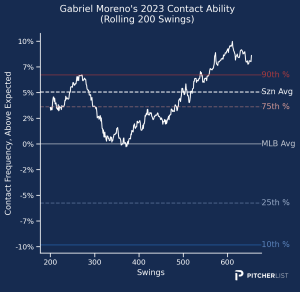
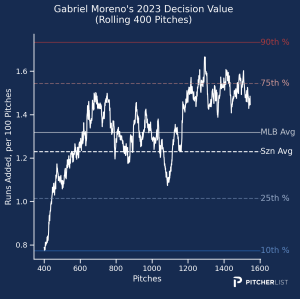
Moreno is unlikely to hit 15 home runs in a season, but his batting average should be north of .280 and the counting stats will be quite good for a catcher (think 120-130 combined runs and RBI). Moreno also has some sneaky speed and should chip in six to eight steals too, if you’re into that sort of thing.
125. Ezequiel Tovar (SS, COL) – It was great to see Tovar get a chance to play the full season as the primary shortstop for the Rockies, even if it came with lackluster results. While I desperately wish I had a rolling chart to show you that indicates growth or improvement, I wasn’t able to find anything of the sort. Growth doesn’t always happen on the field, though, and the one-time top-50 prospect has a good enough hit tool to hit .280 in the big leagues while throwing in 17-19 home runs and close to 15 steals along with whatever counting stats are available in Colorado, but until we start seeing actual signs on the field, it’s hard to call him anything more than an upside gamble.
126. Ronny Mauricio (2B, NYM) – The Mets haven’t yet handed a job to Mauricio for 2024, but between second base, third base, and the outfield, there are opportunities for that to happen this spring. Mauricio has the power and speed to be a 20-20 player if given 130-140 games to get there, and his hit tool should be good enough to keep his batting average from being a negative to your bottom line. If Mauricio does get handed a job, I’d likely raise him at least one or two tiers because of the upside.
Update: Mauricio tore his ACL down in the Dominican Winter League. This likely keeps Mauricio out until late summer or early fall, which limits him to being a stash play in deep leagues with a deep IL.
127. Brandon Drury (1B/2B, LAA) – So much for a power regression, eh? Drury only played in 125 games in 2023, but still managed to hit 26 home runs for the Angels as a follow-up to the 28 he hit back in 2022. I’m inclined to believe that the Drury we saw in 2022 and 2023 is the one we will get in 2024, and that means a .260 batting average, 25-27 home runs, and 150 combined runs and RBI over a full season.
Of course, Drury isn’t known for playing full seasons as he’s never played in 140 games in a season since going pro in 2010. He missed significant time in 2018, 2019, 2020, and 2021, so projecting more than 120 games is a big risk to take. That said, in shallow leagues, he remains an excellent back-end infielder who can provide power and RBI while batting in the heart of the order for a bad team.
128. Trevor Story (2B, BOS) – I remain pretty low on Story, unfortunately, as he’s simply been unable to find any health or consistency since moving to Boston. Strikeouts continue to plague him as he’s maintained a strikeout rate of over 30% since joining the Red Sox, and while injuries may be partially to blame, I expect health will remain an issue going forward.
This ranking respects that a healthy Story could certainly hit 20 home runs and steal 25 bases in 140 games or so, but that version of Story has been fleeting of late. It’s a big-time risk-reward pick that could work out very well, but I wouldn’t make this bet unless I also intended to take a second player with second-base eligibility. For what it’s worth, this ranking would be considerably lower in draft-and-hold formats and other deeper leagues, but the replacement level in standard leagues is high enough that it can’t hurt you that much if it’s a swing and a miss.
129. Jarred Kelenic (OF, ATL) – A surprise trade lands Kelenic in Atlanta, a team who just got more out of Olson, Ozuna, and Rosario than I ever thought possible at this point, so it’s safe to say things are looking up for the maligned outfielder. Kelenic never found his groove with the Mariners in the majors due to strikeout issues, but he continued to rake every time he went back to triple-A. At his prospect peak, Kelenic was viewed as a perennial 20-20 threat who could also hit for average. Atlanta is likely to start Kelenic in a platoon due to their crowded roster and Kelenic’s spotty history against southpaws, but if you want to throw a high-upside dart later in the draft, Kelenic’s upside is as high as anyone’s.
130. Keibert Ruiz (C, WAS) – 2023 was a breakout for Ruiz, and due to his strong hit tool, it could very well be the expectation going forward. The 18 home runs are probably close to the top of what I’d project for him, but the .260 batting average has room to improve thanks to Ruiz possessing one of the best contact abilities in the league that persists across all pitch types. The power is the primary thing to be suspicious of, as he doesn’t make very much hard contact nor does he barrel the ball very often, but Ruiz’s ability to put the ball in play consistently creates a very high floor that should keep him as a set-and-forget catcher in virtually all formats. In points leagues, you can even lift him a tier as he rarely strikes out and should continue to play a lot of games in Washington.
Tier 13
131.Starling Marte (OF, NYM) – Injuries loom large for Marte as he enters his age-35 season but in just 86 games he managed to steal 24 bases in the new environment for the Mets. I’d advise against projecting Marte for more than 110-120 games, but the upside even in that short time could be 10-15 home runs and over 30 steals. That kind of upside is hard to come by at this stage, and in shallow leagues, it makes Marte worth scooping up near the end of the draft.
132. Logan O’Hoppe (C, LAA) – O’Hoppe should be the primary catcher for the Angels, though injuries took him out for most of 2023. While he was healthy, though, O’Hoppe clobbered 14 home runs in just 51 games and while that pace isn’t sustainable, 110 games could give way to 22-25 home runs with a .250 average, and in 130 games (which is all the rage among catchers these days), there’s an outside chance at 30.
133. Jorge Polanco (2B, MIN) – Polanco kept the double-digit walk rate from 2023 (though it came with an elevated strikeout rate) and also slugged an impressive 14 home runs in just 80 games, but it was a second straight season where injuries kept him out for a large chunk of the season. Polanco has 25 home run upside with decent ratios and counting stats as the presumed cleanup hitter in Minnesota, but as is the case with most of this lineup, the biggest question mark is whether he can stay healthy enough to make an impact.
134. Willy Adames (SS, MIL) – Home runs and counting stats shouldn’t be an issue for Adames as 2023 proved that his glove will keep him in the lineup even during the ugliest of slumps. This was the second consecutive season, though, in which Adames was poison to your batting average and OBP, and also his hard hit rate took a noticeable dive to 36.1%. He’d been in the mid-40s as a Brewer from 2021 to 2022, and unless Adames can hit the ball with authority more consistently, he could get buried in the lineup again. That would cap his counting stat ceiling significantly and make it even harder to stomach the .220 to .230 batting average we have to expect from Adames in 2024.
135. Josh Bell (1B, MIA) – It may not always be pretty, but Bell once again found a way to drive in more than 70 runners and hit more than 20 home runs between his time with the Guardians and Marlins, with his best stretches coming with the latter. Bell will once again be a Marlin, and if he can recreate the 37.2% fly ball rate (which is about as high as it gets for Bell), we should see another 20+ home run season with improved counting stats. There’s also a chance he goes back to hitting grounders and becomes waiver material, but the 23-25 home run, 80 RBI upside with good ratios is worth gambling on as a late corner infielder.
136. Jack Suwinski (OF, PIT) – Suwinski has issues with zone contact (which you may have noticed is a red flag for me), but a combination of power, speed, and playing time still led to 26 home runs and 13 steals for the 25-year-old southpaw. Suwinski is much better suited to OBP leagues where his high walk rate can make his ratios more than acceptable, but in standard leagues, you shouldn’t expect more than a .220 average with subpar counting stats as part of a dismal Pirates lineup.
137. Alex Verdugo (OF, NYY) – Verdugo was exceptionally average last season as he saw his batting average fall to a middling .264 after five straight seasons hitting at least .280, but a move to the Bronx and a presumably better lineup should hopefully squeeze more juice out of the contact-oriented outfielder. Additionally, if LeMahieu struggles at all in the leadoff spot, Verdugo would probably be the next man up to take that role in front of Judge and Soto, and it wouldn’t be hard to imagine Verdugo piling up a ton of runs scored in that role.
138. Sean Murphy (C, ATL) – It was a tale of two halves for Murphy, who posted a .999 OPS with 17 home runs and 97 combined runs and RBI in the first half only to suddenly start riding the pine three to four days a week (which started in June) and struggled to the tune of a .585 OPS and just four home runs and 33 combined runs and RBI in the second half. It was a truly baffling collapse for him, as his strong defense behind the plate would normally have him starting most days. That timing suggests that maybe the hamstring issue that popped up in June impacted him throughout the season, but we have yet to be given any concrete information about why his role changed so suddenly. That lack of insight makes me extremely worried about relying on him in 2024, but the upside from the first half necessitates that I rank him in the top 150.
139. Wyatt Langford (OF, TEX) – Langford went from complex ball to triple-A all in the course of about half a season in the Rangers’ system, and there are good reasons to expect Langford to get the call to the majors early in 2024. Given 120 major league starts, Langford’s power and speed could help him get to 20 home runs and 20 steals and his hit tool should carry with it a decent set of ratios. It’s also very possible that the logjam of talent the Rangers have in the outfield and at DH never provides an opportunity for Langford to play every day and that he spends 2024 ripening in triple-A. This is the ranking for Langford if/when he has a role in the starting lineup, which is the more interesting ranking right now.
140. Esteury Ruiz (OF, OAK) – NFBC players will take Ruiz a lot earlier than this due to the fact he’s almost certain to lead the AL in stolen bases after swiping 67 bags in 2023, but keep in mind that Ruiz fell short of 50 runs scored and 50 RBI and that the .254 batting average and .309 OBP are just about as good as it’s going to get due to his aggressive approach and complete lack of power. He will steal a boatload of bases and not hurt your ratios that much, which is not super valuable in head-to-head categories formats, but those in roto leagues will probably have him in a tier or two above this.
141. Nolan Gorman (2B, STL) – The 27 home runs in 119 games isn’t that surprising for those who followed Gorman as a prospect, and neither is the 32.3% strikeout rate he’s shown in 208 career games in the majors. Gorman’s extreme contact issues make him a wildly volatile player in both real life and fantasy, especially since he’s not especially good at making contact even when he’s not chasing pitches. The Cardinals weren’t afraid to bench him against lefties and shuffle their lineup around to cover for it, and I do expect that to continue until Gorman adjusts.
Tier 14
142. Ty France (1B, SEA) – While France is still a useful source of plate appearances and counting stats due to getting over 600 plate appearances for three straight seasons, the upside is limited due to modest power and a complete lack of speed. A return to 20 home runs isn’t out of the question, but with with questions about the Mariners’ ability to score runs consistently could put a damper on France’s counting stat accumulation. He’s a high-floor player in deeper leagues and will have stretches of high production due to his durability and lineup spot, but those in 12-team leagues will often be left wanting for more.
143. Anthony Rizzo (1B, NYY) – Rizzo folded after a hot start, slashing just .172/.271/.225 over the last 46 games he played before hitting the IL with a concussion. He was so bad that it was easy to forget that Rizzo had 11 home runs and a .305 batting average at the end of May, and there’s still a distinct likelihood that Rizzo starts the season as the number four hitter behind Judge and Soto. A return to the 30 home runs he hit in 2022 as a Yankee would easily get Rizzo to 100 RBI, but he’ll need to find consistency that just wasn’t there last season.
144. Carlos Correa (SS, MIN) – Believe it or not, this was the fourth consecutive season that Correa appeared in over 80% of his team’s games, though unlike the two previous campaigns, it was not considered a success. Correa fell flat in almost every category, and one explanation could be the plantar fasciitis he battled throughout the season. Assuming Correa finds a way to manage the condition over the offseason (it doesn’t require surgery), he could certainly recapture his 2021 or 2022 form and put up 22-25 home runs with solid counting stats and a .280 or better batting average. The floor is particularly low for the former first-overall pick, but there’s enough ceiling here that someone should probably draft him in your league.
145. Matt Chapman (3B, TOR) – Chapman’s hard-hit rate in 2023 was the best of his career (by a pretty wide margin) despite putting up 10 fewer home runs than he had in each of the last two seasons. Part of the issue may have been luck, as Chapman’s 39 doubles were 12 more than he hit in 2022 and 24 more than he had in 2021, and he also didn’t pull the ball as much as he did in 2022. 25-30 home runs are possible for Chapman no matter where his free agency takes him, but his strikeouts, streakiness, and low batting average will frustrate even the most patient fantasy managers.
146. Jonah Heim (C, TEX) – Heim was not the same hitter after hitting the IL in late July, hitting just .202/.268/.333 in 41 regular season games. That injury and following slump allowed Garver to steal Heim’s spot in the lineup, and as it stands now, it’s hard to see Heim climbing back to the top two-thirds of the order. 20 home runs is a reasonable expectation due to the volume we should expect for Heim in 2024, but the ratios, which historically were putrid, are hard to project. If he finds his first-half form, this is a top-five catcher, but the .214/.275/.374 line from his pre-2023 career would make Heim a very difficult catcher to roster for a full season.
147. James Outman (OF, LAD) – Outman’s poor zone contact numbers early in the season led to an ugly slump that saw him hit the waiver wire in most standard leagues, but there were signs of optimism late in the season as he steadily improved his contact ability. Fastballs, in particular, were a huge weakness for Outman when it came to contact despite the fact he was excellent at making the correct swing decisions against them. On the bright side, Outman did get better at connecting with fastballs, and more growth could certainly happen.
Whiffing on strikes is a big red flag to me, as that can be more indicative of a talent problem than a mental problem, Outman’s power does present enough upside to keep me intrigued for 2024, just not as one of my first three outfielders.
148. Jeff McNeil (2B/OF, NYM) – McNeil is essentially Arraez-lite. He puts a ton of balls in play, rarely strikes out, and scores runs. He doesn’t do those things quite as well as Arraez, but McNeil does them consistently. McNeil is slightly more likely to get to double-digit home runs and steals, but 10 is pretty close to the cap for him in both categories.
149. José Abreu (1B, HOU) – I never really bought into Abreu in 2023 due to his lackluster 2022, but if the 37-year-old first baseman can find a path back to even a .250 batting average, he’s a threat to drive in 100 runners in the heart of the Houston lineup.
150. Tommy Edman (2B/SS/OF, STL) – I was not at all in on Tommy Edman in 2023 due to his move to the bottom of the order and his historical performance in that spot, and while Edman has a clear starting role and is coming off a third straight season with at least 27 home runs, I’m still not overly excited about the other assets Edman brings to the table. Edman finished as the 130th best hitter last season according to the FanGraphs auction calculator with stolen bases being the only category where he didn’t provide negative value. I don’t see much reason to suspect anything to improve much in 2023, which makes Edman better suited to deeper roto leagues than anything else for the speed.
Tier 16
151. Jake Cronenworth (1B/2B, SDP) – Cronenworth could find his way back to the heart of the order with Soto now in New York, and hitting between some combination of Bogaerts, Machado, and Tatis is a good way to drive in 80 runners and score 80 runs. The batting average will likely be .240 or worse and he’s not likely to exceed 15 home runs, but Cronenworth should play enough to accumulate counting stats and be a high-floor, low-ceiling option for those in deeper formats.
152. Leody Taveras (OF, TEX) – Tavares should find a way to get to 15 home runs and 15 steals in 2024 if he stays healthy as he fell only just short of those marks in 2023. I don’t think there’s much upside for more than that and Tavares is likely to stay buried at the bottom of the Texas lineup, so as long as your counting stat expectations are low, you won’t be disappointed.
153. Jordan Lawlar (SS, ARI) – Lawlar was excellent in the minors but struggled mightily in his brief major league debut. If the hit tool can adapt to major league pitching, this could be a 15 home run, 20-25 stolen base shortstop with a .240-.250 average. I expect more growing pains than that, though, which makes Lawlar more of a stash than a start.
154. Eugenio Suárez (3B, ARI) – Suárez is no longer the lock for 30 home runs he was from 2018-2022, but assuming the D-Backs intend to deploy Suárez in the middle of their lineup, then he should still drive in 80-90 runners even if the home run total is closer to 20 than it is to 30 despite the ugly batting average.
155. Max Kepler (OF, MIN) – Kepler is tough to appreciate in 12-teamers as he lives right around the replacement level most of the time, but his second half in 2023 certainly caught my attention as he put up a .926 OPS with a .306 batting average. Kepler has been unable to handle left-handed pitching for most of his career, though.
156. Tommy Pham (OF, FA) – The veteran outfielder is coming off his most productive season since 2023 as he looks to find work with what could be his fifth team in three seasons. It’s difficult to pinpoint specific reasons for his improved stat line other than the new stolen base environment, and it’s not easy to think of a team that’s going to be willing to give a 36-year-old free agent a chance to bat cleanup like they did in Arizona last season, but Pham could work his way to 15 home runs and 15 steals if given an everyday opportunity.
157. Bryan De La Cruz (OF, MIA) – De La Cruz was a boring yet reliable back-end outfielder last season, finishing just inside the top 50 at the position thanks to his 78 RBI and high volume. If De La Cruz can stay in the top five or six spots in the order, we should see something like a repeat of his 2023 line, though the counting stats may take a step back as he’s not likely to get 41 games hitting third unless a few injuries pop up.
158. Brandon Lowe (2B, TBR) – Lowe has the pop to hit 30 home runs, but injuries, inconsistency, and platoon splits continue to hold him back. If you’re desperate for power late in the draft, Lowe is a gamble worth considering, but at this point, it’s just a gamble.
159. Brendan Donovan (2B/OF, STL) – Remember the stuff I said about McNeil? That all applies to Donovan except for the fact that Donovan has missed almost half of 2023 with an elbow injury and also is at risk of landing on the large side of a platoon if he continues to slug under .300 against left-handed pitching. He should provide solid ratios against righties with double-digit home run power and a little bit of speed, but there’s a lot of playing time risk that comes with it.
160. Austin Hays (OF, BAL) – It’s unlikely that there’s another level to his game, and most of his value comes from hitting fifth and playing a lot. The primary issue with Hays is that when he’s bad, he’s exceptionally bad, such as the 24-game stretch shortly after the All-Star Break where he hit .172/.215/.241.
161. Kris Bryant (OF, COL) – Over his first 32 games, Bryant hit .300/.387/.467 with five home runs and things looked like they’d finally work out for him in Colorado. Unfortunately, nothing went right for Bryant after that as he had two IL stints that lasted over a month each and posted a pitiful 40 wRC+ in the games he did play in over the rest of the season. Entering his third year of a seven-year deal, Bryant has only appeared in 122 games, but the first chunk of 2023 combined with his short yet strong 2022 still leaves a tiny morsel of hope that he could be a top 40 outfielder, though it comes with huge injury and performance risk.
Tier 17
162. Byron Buxton (UT, MIN) – 2017 stands alone as the sole season where Buxton played at least 100 major league games as he found his way into just 85 of them in 2023 before hitting the IL. The Twins still expect him to be their starting centerfielder, and we saw enough to still project Buxton for 30 home runs if he somehow plays in 140 games and could also steal 15 bases. We also saw enough to know that Buxton’s ratios are probably going to stay low due to his extreme flyball tendencies, but if you want to pick up a lottery ticket, Buxton still fits the bill.
163. Bo Naylor (C, CLE) – The younger Naylor enters 2024 as the starting catcher for Cleveland, and while he was inconsistent in his 2023 debut, there’s enough power upside to see a path to 20 home runs and five to seven stolen bases. His high walk rate makes him a lot more viable in OBP leagues, but those in standard leagues who decided to wait until the last pick on a catcher might as well throw a dart on Naylor’s upside.
164. Kyle Manzardo (1B, CLE) – Manzardo hit his stride after moving to Cleveland’s triple-A affiliate (the Columbus Clippers) and finished his 2023 with 17 home runs in 97 games. Given a full season in the majors, Manzardo could club his way into 17-19 home runs with an excellent OBP and a decent batting average. Cleveland’s Progressive Field is the eighth-toughest park on left-handed power according to Statcast’s Park Factors, though, and Manzardo’s power isn’t what you’d usually expect from a first-base prospect. We don’t see a lot of hit tool-first first basemen (Domonic Smith and Josh Bell come to mind?), but those in points leagues should take special notice of Manzardo as late late-round flyer.
165. Ryan McMahon (2B/3B, COL) – While McMahon’s 2023 seems productive on the surface, a huge amount of his production came over a 50-game hot streak over the summer where he hit .299/.388/.540 with 60 combined runs and RBI and 10 home runs. Before the streak, McMahon had a pedestrian .675 OPS, and afterward, he had a .672 OPS. That’s 50 games of good production and 102 games of sandbagging your stats. Throw in a rising strikeout rate and a horrible offense around him, and you have a player who can contribute to your counting stats when he’s at home and who should otherwise be on the wire.
166. Brendan Rodgers (2B, COL) – The third pick of the 2015 draft hasn’t quite lived up to what was expected, but his blend of hit tool and power has me coming back to the well one last time in deep drafts to see if he can put together a 17-20 home run season with a .275 batting average. It’s not impossible as he’s only 27 years old and will have every opportunity to be a key player for the Rockies, but it gets less likely by the season.
167. Sal Frelick (OF, MIL) – Frelick doesn’t have much in the way of power (his career single-season high is 11 home runs across three levels in 2022), which makes the fact that the Brewers hit him fourth so often in 2023 quite the surprise. Milwaukee’s relatively thin roster means Frelick is currently slated as the third or fourth hitter in this lineup heading into 2024 behind Yelich and Contreras, and if that holds then Frelick could be a candidate to drive in 80 runners with double-digit home runs and stolen bases. He’s likely not much more than barely above replacement level in 12-teamers, but those in deeper leagues or points leagues may get more mileage out of his low strikeout rates and ability to put the ball in play.
168. Brent Rooker (OF, OAK) – Rooker was a home run machine at the beginning and end of the season, but in between those outbursts was a brutal 69-game stretch where he struck out in 35.2% of his plate appearances and slugged just .358. Rooker struggled to make good swing decisions with two strikes on him, and his poor zone contact skills suggest this kind of volatility will continue to be part of his game. The home run total may very well be over 30 in 2024, but you’ll probably only want to roster him for about 50-60% of his plate appearances to get maximum value.
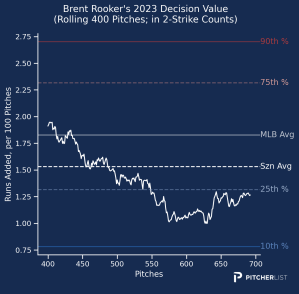
169. Jeremy Peña (SS, HOU) – Peña’s 2023 was an improvement in some areas, such as plate discipline and OBP, but it came with a huge downturn in power thanks to a much higher groundball rate that he was not useful for fantasy. If Peña can get back to 20 home runs to go with his improvements at the plate and his 13-15 stolen bases, he could be a very steady contributor in the middle infield. If he once again barely manages double-digit home runs, he’s not worth rostering in 12-teamers. The one thing Peña has going for him, though, is that his glove will keep him in the lineup every day, meaning he’ll have every opportunity to find a way back to his 2022 self.
170. Will Benson (OF, CIN) – Apart from a 31.3% strikeout rate, and a wRC+ of 3 against lefties (not a typo, he was 97% worse than average players against same-side pitching), there was a lot to like about Benson’s 2023 season. The crowded Reds roster makes a full-time role all but impossible to imagine for Benson, but as a platoon player, he can certainly get to 15 home runs and 15 stolen bases. The .275 batting average will almost certainly come down to something more like .230-240 due to his zone contact issues and some normal luck regression, but he’ll be very streamable throughout the season.
171. Wilmer Flores (1B/3B, SFG) –2023 was arguably the best season of Flores’ career and he enters 2024 as the number four hitter in the lineup and everyday DH. Free agents could muddle things up a bit depending on their skill set, but look for Flores to roughly 20 home runs with decent counting stats and a batting average around .260-.270.
172. Zach Neto (SS, LAA) – Neto ran into serious trouble during his debut in 2023 and saw his contact ability decline sharply throughout his season. Assuming he can figure out how to make more contact, Neto could be the leadoff guy for the Angels and hit 20 home runs and 10 stolen bases with a .250-.260 average, but fixing contact issues is not a simple endeavor.
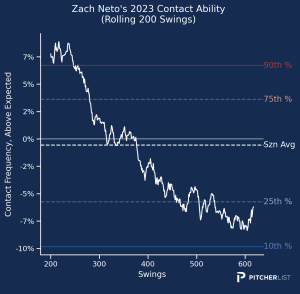
173. Parker Meadows (OF, DET) – Meadows’ 22 home runs and 27 stolen bases across the majors and minors last season were exciting, particularly for action-starved Tigers fans like myself, but Meadows’ hit tool will likely limit his contributions to something closer to 15 in each category, assuming he gets a full season of plate appearances. His willingness to take a walk should give him a leg up on the leadoff spot in Detroit, so if Meadows continues to walk more than 10% of the time and keeps that strikeout rate around 25% or lower, he could provide 80 runs and sneak his way into the top 150 hitters.
174. Jung Hoo Lee (OF, FA) – The former Kiwoom Hero missed a large chunk of 2023 due to an ankle injury that required surgery, but the 25-year-old import has an excellent hit tool that could parlay itself into a high batting average with 15 home runs. Adjusting to major league fastballs is the biggest step most players need to take (in terms of actually playing baseball) when they come over from an international league, but if Lee can adjust quickly then he could quickly make an impact in 2024.
175. Jordan Westburg (2B/3B, BAL) – Westburg could hit 20 home runs in a full season in the majors with workable ratios and counting stats, however; Baltimore isn’t likely to give him that many plate appearances unless there’s an injury or trade that clears up more room on their roster. Between Henderson being the man at third and youngster Connor Norby banging on the door to the majors, it’s hard to see Westburg getting more than 120 games in 2024, but if he does, he can be a solid piece to the back end of a fantasy roster.
176. Whit Merrifield (2B/OF, FA) – Landing place and role will play a big part in how we rank Merrifield. If he lands somewhere that he will be given the chance to hit near the top of the lineup with a manager who likes to steal bases, Merrifield had a chance to be a top-120 hitter. If he goes somewhere that wants him to hit near the bottom of the lineup with a manager who is conservative on the base paths, then he could fall outside the top 200.
177. Gavin Lux (2B/OF, LAD) – Lux missed all of 2023 with a knee injury he suffered shortly before the start of the season, but returns in 2024 with the keys to the starting shortstop job. Once a top-five prospect, our expectations for Lux have fallen dramatically after 273 very average games (for fantasy purposes) to start his career. I suppose you can see 15 home runs and 10 steals if you squint a bit, but Lux’s only bankable value comes from his strong plate discipline which should lead to a .270 batting average and .350 OBP.
178. Andrew Benintendi (OF, CWS) – Two straight seasons of hitting just five home runs suggests the power outage is here to stay, but expect the White Sox to keep Benintendi at the top of the lineup in 2024, giving him a chance to score 70 runs or so and steal 10-15 bases with a decent batting average. He won’t provide anything else that’s helpful, but at least it ain’t nothing.
179. Pete Crow-Armstrong (OF, CHC) – Crow-Armstrong wasn’t able to get a hit in his first 19 plate appearances in the major leagues, but given that he should start at least 100 games in 2024, I’m sure he’ll get that first one eventually. In all seriousness, PCA could hit 15 home runs and steal 20 bases given a full season, but there isn’t currently a clear path to playing time with Tauchman, Happ, and Suzuki currently assuming the three outfield roles. Crow-Armstrong is worth a dice roll in leagues where you have the bench room to stash a guy for upside, but is more of a watchlist add in shallower leagues.
Tier 19
180. Giancarlo Stanton (OF, NYY) – Stanton hits the ball unbelievably hard and misses a lot of games. It was true before, and it’s true now. The only real change in his game is that between the strikeouts, the flyball-heavy approach, and the loss of speed, Stanton is an extreme drag on your batting average and OBP. He only needs about 110 games to hit 30 home runs, but even getting that many will take some luck.
181. Luis Rengifo (2B/3B/SS/OF, LAA) – The super-utilityman Rengifo started walking a lot more than he had in 2021 and 2022, but other than that, it’s hard to imagine him being more than the 16-18 home run hitter with decent ratios that he’s been for the last two seasons. You’ll probably pick up Rengifo at various points in the season when dealing with injuries or when he’s heating up, but you don’t need to draft him in a format that includes a waiver wire.
182. Nelson Velázquez (OF, KCR) – Velázquez made waves once he was traded to the Royals, hitting 14 home runs in 40 games, though it came with a 29.3% strikeout rate and a .233 batting average. That more or less tracks with what we expected of him as a prospect, making him a lower batting average guy with a 25-30 home run upside. Some power hitters can get by with a low-walk approach (like his teammate Salvador Perez), but he’ll likely need to cut the strikeout rates to find any real consistency.
183. Colt Keith (3B, DET) – Keith hit for power and average in the high minors in 2023, flying up prospect rankings in the process. There isn’t technically an opening in the Tigers’ roster for him at the moment, but if Detroit decides to move on from Vierling or McKinstry as everyday guys, Keith could sneak his way into the lineup and would be immediately in the top 150 hitters,
184. Alex Kirilloff (1B/OF, MIN) – Kirilloff’s hit tool and power could make him a valuable first baseman or outfielder in fantasy, but the injuries have never stopped piling up, allowing other players to get a chance to steal his spot in the lineup. If given the chance to play 120-140 games, Kirilloff could provide a .270 batting average with 17-19 home runs and decent RBI totals, but between a roster logjam and ever-present injury concerns, it’s hard to imagine Kirilloff getting that chance.
185. Matt Wallner (OF, MIN) – Wallner has a difficult path to a full-time role due to the nature of the Twins roster and his weakness to left-handed pitching, but there’s no doubting his raw power after he hit 14 home runs in 76 games. Keep Wallner in the back of your mind, especially in OBP formats, when you need power at the end of a deep draft or during the season when perusing the wire, but even if Wallner is healthy for all of 2024, it’s unlikely he gets to 120 games played while in a strict platoon.
186. Joey Meneses (UT, WAS) – Meneses provided solid batting average and counting stats in his first full season in the majors, but the 13 home runs were as many as he had hit in just 56 games in 2022. Meneses hits a lot of ground balls and also pops out quite a bit, so I’m not comfortable projecting more than 15 or so in 2024.
187. Junior Caminero (3B, TBR) – The path to regular playing time is exceptionally murky considering the infield in Tampa is quite full and also because it’s Tampa so everyone’s playing time is murky, but there’s a reason the Rays let Caminero make his MLB debut shortly after his 20th birthday. While he didn’t set the world on fire, Caminero was far from overmatched by big league pitching, and given the opportunity, Caminero could hit 20-25 home runs for the Rays. I expect him to start the season in triple-A, but once a path to regular at-bats opens up, be ready to pounce.
188. Luke Raley Jr. (1B/OF, TBR) – 19 home runs and 14 steals is nothing to sneeze at, but Raley’s issues with left-handed pitching and strikeouts combined with the fact that the Rays love to mix and match their lineup means 120 games is probably the ceiling for him. It also doesn’t help that Raley lost his fire down the stretch, hitting .196/.272/.366 with a 35.2% strikeout rate in his final 36 games.
189. Justin Turner (1B, FA) – It was a great season on all accounts for the now-39-year-old Turner and he heads into free agency after setting career highs in runs scored and RBI. It’s hard to imagine there’s a lot of tread left on these tires, but if Turner manages to land in another prime location, he could easily move into the top 150.
190. Garrett Mitchell (OF, MIL) – Mitchell has the pop and speed to hit 15 home runs and steal 15-20 bases, but his hit tool was exposed in a big way in the majors. If he can get that strikeout rate below 30%, Mitchell would have an outside chance at regular playing time, but until he proves he can handle MLB stuff, he’s likely stuck in triple-A.
191. Amed Rosario (2B/SS, FA) – No matter where Rosario ends up, a .270 batting average and 10-12 home runs with 15 steals will likely follow. If that lands at the bottom of a team’s batting order, it’s replacement-level stuff that you can leave on the wire most of the time in a 12-teamer. If it finds its way near the top of the order, that’s a different conversation.
192. Maikel Garcia (3B, KCR) – Does five to seven home runs and 25 stolen bases with average ratios excite you? Then Garcia is your man. That’s extremely replaceable in most 12-team formats, but those in 15-team leagues will likely have Garcia much higher on your boards.
193. Chris Taylor (3B/SS/OF, LAD) – I’m sure Taylor will finesse his way into 120 games again for the Dodgers somehow, though the strikeout rate stayed over 30% once again which means his batting average is probably stuck below .240 going forward. You’ll probably stream him at some points when he faces a lefty-heavy slate of games, but otherwise, the upside is too low to pay much attention to in 12-team formats.
194. Ezequiel Duran (3B/SS/OF, TEX) – Duran is too aggressive most of the time with pitches he needs to leave alone, but he made it work in 2023 and put up strong ratios with some pop and speed. I feel pretty strongly that he’s the odd man out in Texas with kids like Carter and Langford on the rise, but if a few guys hit the IL as they did in 2023, then Duran will have some streaming appeal.
195. Jose Siri (OF, TBR) – Injuries and roster shuffling will keep his total plate appearances down, but Siri has an elite combination of power and speed that will be relevant to us at various points in the season. He strikes out way too much and goes through long cold spells multiple times a season, but Siri is always worth keeping on your watch list when you require home runs or steals and don’t care about the ratios.
196. Alek Thomas (OF, ARI) – There still could be 15 home runs and 15 steals in Thomas’s future, but it’s locked behind a career 56.8% groundball rate in the majors that wasn’t much better in the minors. Players can and do fix this issue, but it’s not easy nor common for the change to stick long-term.
197. James Wood (OF, WAS) – The top five prospect doesn’t have a clear path to a starting role and will almost certainly start the season in triple-A to work on his decision-making and strikeouts, but when he’s ready, watch out. Wood has some of the biggest raw power in the minors with an above-average hit tool and a bit of speed to go with it. He has true 30-15 potential, it’s just a matter of being able to cut down the strikeouts and pick the right battles for him.
198. Masyn Winn (SS, STL) – It was a debut to forget for Winn in 2023, but he should slot in as the starting shortstop for the Cardinals in 2024 and could certainly work his way to 10 home runs and 15 steals if he makes a few adjustments. Until that happens, though, he’ll be stuck at the bottom of the batting order and providing too little of anything to be roster-worthy in standard leagues.
199. Edward Olivares (OF, KCR) – The Royals continue to show no real interest in letting Olivares play consistently in the outfield despite a solid .270/.322/.439 line with 16 home runs and 13 steals in the 159 starts since the beginning of 2022. If I felt like the Royals and the injury demons were going to give Olivares the chance to play another 159 games in 2024, he’d be several tiers higher than this.
200. Jasson Domínguez (OF, NYY) – Dominguez will miss the first half of the season (at least) due to injury, but if you have plenty of IL spots or can keep him on your minor league roster, then go ahead and scoop him up at the end of the draft. Statcast data fully supported the surprisingly strong (but brief) debut of The Martian, and I suspect he’ll quickly regain a starting role in the outfield (even if Aaron Boone is trying to suggest otherwise).

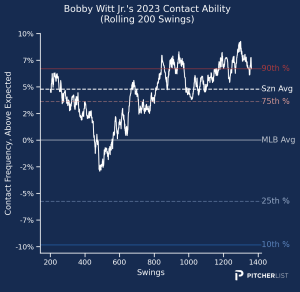
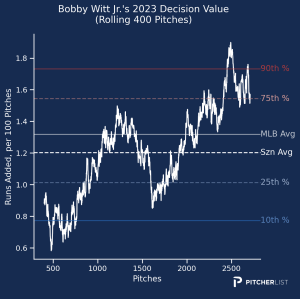
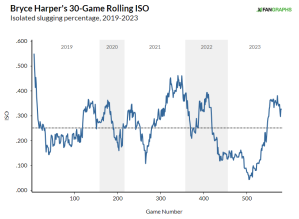
Nice list, Scott. On my dynasty team I have my position players ranked exactly in the order you have them.
That must mean we are both wrong… 🙂
At least we are in it together.
Great work Scott. Extensive work done and very much appreciated.
Thanks for checking it out, Pat! I hope it provided at least 1 interesting thing to think about.
People are happier if they are more financially independent. Make 120 to 180USD / Hr by performing simple tasks. We can help you achieve this. Join our strong community and earn money easily and safely from wherever you want.
Take a look……………………………………..
People are happier if they are more financially independent. Make 120 to 180USD / Hr by performing simple tasks. We can help you achieve this. Join our strong commuanity and earn money easily and safely from wherever you want.
Take a look……………………………………..